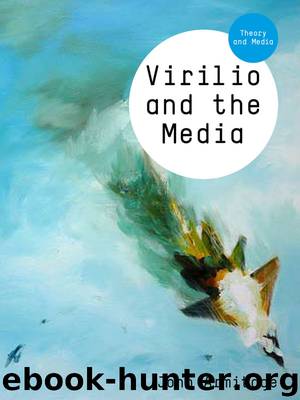Virilio and the Media by Armitage John;

Author:Armitage, John;
Language: eng
Format: epub
Publisher: Polity Press
4
CITY OF PANIC
The Instrumental Image Loop of Television and Media Events
INTRODUCTION
The purpose of this chapter is to consider Virilio’s (2005b) conception of the “city of panic,” which arises from his media theory. It does so through interpretations of four of Virilio’s texts (2000c, 2002b, 2005b, 2007a), all of which continue many of the themes and concepts introduced in The Aesthetics of Disappearance, War and Cinema, The Vision Machine, and Polar Inertia, and by focusing on issues related to what I shall call “the instrumental image loop of television” and media events. The important question that steers this chapter is therefore: What kind of “landscape of events” (Virilio 2000c) or media theory is feasible, given the post-modern escalation of the modern technical beyond of “flying into the unknown"? In answering this question, the present chapter will summarize the arguments that Virilio (2005b) employs, and it will do so in order to ask media- and event-based questions about “the mutation of terrorism” and "theatrical militarism,” “visual discourses of distraction” and the “synchronization of emotions,” which will be contemplated in greater detail in the next four sections.
A LANDSCAPE OF EVENTS : THE MUTATION OF TERRORISM
In A Landscape of Events Virilio examines the mediated and urban connotations of his philosophy and describes what he sees as the role of television when one considers it with regard to the escalation of the modern technical beyond.
In “Delirious New York” Virilio offers one of his most unambiguous formulations about the relationships between events and the cityscape:
The [1993] attack on the World Trade Center is the first of the post-Cold War. No matter who is responsible, it ushers in a new era of terrorism having nothing in common with the explosions that regularly rock Ireland or England. (2000c: 18)
Terror attacks are part of the landscape of events: they question the post-Cold War order and destroy the culture in which we live, while waging war on the status quo. Still, for Virilio, this questioning and destruction is linked to questions of television. He argues that televised media events entail, and emerge from, what he calls a “new era of terrorism” (ibid.). This is an era distinct from that of the “old era of terrorism.” The old era of terrorism belonged in the age of nuclear deterrence and operated in the sphere or age of the balance of terror: it identified and described something similar to minor political crime; for instance, the “petty terrorism” of the age of nuclear deterrence indicated a situation that concerned “the traditional supremacy of ‘weapons of destruction’ [e.g. the atom bomb] and ‘weapons of obstruction’ [e.g. fortifications]–in other words, the duel of arms and armor” (p. 21). The new era of terrorism is part of a different form of attack: it does not merely change a situation but destroys it. Examples include the serious intention to bring down the World Trade Center in 1993, or the destruction of the Mumbai Stock Exchange on March 13, 1993. In both instances, there is no overt effort simply
Download
This site does not store any files on its server. We only index and link to content provided by other sites. Please contact the content providers to delete copyright contents if any and email us, we'll remove relevant links or contents immediately.
The Art of Boudoir Photography: How to Create Stunning Photographs of Women by Christa Meola(18537)
Red Sparrow by Jason Matthews(5390)
Harry Potter 02 & The Chamber Of Secrets (Illustrated) by J.K. Rowling(3622)
In a Sunburned Country by Bill Bryson(3483)
Drawing Cutting Edge Anatomy by Christopher Hart(3454)
Figure Drawing for Artists by Steve Huston(3381)
Harry Potter and the Prisoner of Azkaban (Book 3) by J. K. Rowling(3304)
The Daily Stoic by Holiday Ryan & Hanselman Stephen(3235)
Japanese Design by Patricia J. Graham(3110)
The Roots of Romanticism (Second Edition) by Berlin Isaiah Hardy Henry Gray John(2878)
Make Comics Like the Pros by Greg Pak(2852)
Stacked Decks by The Rotenberg Collection(2812)
Draw-A-Saurus by James Silvani(2656)
Harry Potter and the Deathly Hallows (7) by J.K. Rowling(2641)
Tattoo Art by Doralba Picerno(2600)
On Photography by Susan Sontag(2575)
Churchill by Paul Johnson(2506)
The Daily Stoic by Ryan Holiday & Stephen Hanselman(2459)
Drawing and Painting Birds by Tim Wootton(2438)
